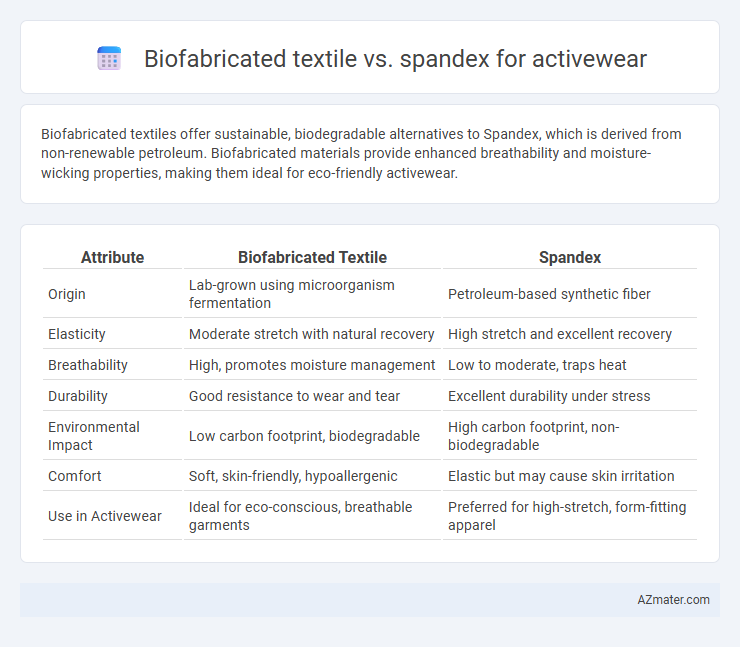Biofabricated textiles offer sustainable, biodegradable alternatives to Spandex, which is derived from non-renewable petroleum. Biofabricated materials provide enhanced breathability and moisture-wicking properties, making them ideal for eco-friendly activewear.
Table of Comparison
| Attribute | Biofabricated Textile | Spandex |
|---|---|---|
| Origin | Lab-grown using microorganism fermentation | Petroleum-based synthetic fiber |
| Elasticity | Moderate stretch with natural recovery | High stretch and excellent recovery |
| Breathability | High, promotes moisture management | Low to moderate, traps heat |
| Durability | Good resistance to wear and tear | Excellent durability under stress |
| Environmental Impact | Low carbon footprint, biodegradable | High carbon footprint, non-biodegradable |
| Comfort | Soft, skin-friendly, hypoallergenic | Elastic but may cause skin irritation |
| Use in Activewear | Ideal for eco-conscious, breathable garments | Preferred for high-stretch, form-fitting apparel |
Introduction to Biofabricated Textiles and Spandex
Biofabricated textiles are engineered materials created using biological processes such as microbial fermentation or cell culture, offering sustainable alternatives to traditional fabrics. Spandex, also known as elastane, is a synthetic fiber renowned for its exceptional elasticity and durability, commonly used in activewear for its stretch and shape retention properties. While spandex provides high flexibility and comfort, biofabricated textiles emphasize eco-friendly production and biodegradability, making them a promising innovation in sustainable activewear development.
Composition and Material Sources
Biofabricated textiles for activewear are primarily derived from cultured cells or engineered microbes, producing proteins like collagen or spider silk that mimic natural fibers, offering sustainable and biodegradable alternatives. Spandex, a synthetic fiber made from polyurethane, relies on petrochemical sources, providing exceptional elasticity but with significant environmental impact due to its non-biodegradable nature. The innovative biofabricated materials prioritize renewable inputs and lower carbon footprints, contrasting with Spandex's conventional fossil fuel dependency and chemical-intensive production process.
Sustainability and Environmental Impact
Biofabricated textiles for activewear significantly reduce environmental impact by utilizing lab-grown proteins and cellulose, which require less water, land, and energy compared to traditional Spandex production. Spandex, a petroleum-based synthetic fiber, generates high CO2 emissions and contributes to microplastic pollution during washing, posing substantial ecological challenges. Transitioning to biofabricated textiles supports circular fashion initiatives and decreases reliance on fossil fuels, promoting a more sustainable activewear industry.
Performance and Durability in Activewear
Biofabricated textiles offer superior moisture-wicking and breathability compared to traditional Spandex, enhancing comfort during intense workouts. Their engineered fibers provide increased tensile strength and resistance to wear, resulting in longer-lasting activewear that maintains shape and elasticity after repeated use. Unlike Spandex, biofabricated textiles often incorporate sustainable materials without compromising the high-performance and durability demands of athletic apparel.
Breathability and Moisture Management
Biofabricated textiles offer superior breathability compared to traditional spandex, utilizing innovative fibers engineered to enhance airflow and reduce heat retention during physical activity. These advanced materials excel in moisture management by efficiently wicking sweat away from the skin, ensuring quicker drying times and maintaining comfort throughout intense workouts. Spandex, while stretchy and form-fitting, typically lacks the same level of moisture-wicking technology, often resulting in trapped heat and less effective sweat evaporation.
Comfort and Fit Characteristics
Biofabricated textiles offer enhanced breathability and moisture-wicking properties compared to traditional spandex, improving overall comfort during intense physical activities. Their customizable fiber composition allows for tailored stretch and recovery, providing a superior fit that adapts to diverse body shapes without compromising mobility. Unlike spandex, biofabricated materials often exhibit better temperature regulation and reduced skin irritation, making them ideal for prolonged activewear use.
Biodegradability and End-of-Life Solutions
Biofabricated textiles offer superior biodegradability compared to Spandex, which is a synthetic polymer known for its persistence in landfills and marine environments. These biofabricated materials decompose naturally within months under composting conditions, significantly reducing environmental impact and facilitating circular economy practices. In contrast, Spandex requires chemical recycling processes that are energy-intensive and not widely available, complicating end-of-life solutions for activewear brands striving for sustainability.
Consumer Acceptance and Market Trends
Biofabricated textiles are gaining traction in the activewear market due to their sustainability and innovative appeal, attracting environmentally conscious consumers who seek alternatives to traditional materials like Spandex. Market trends indicate increasing investment and product launches featuring biofabricated materials, driven by rising demand for eco-friendly activewear that does not compromise performance or comfort. Consumer acceptance is bolstered by growing awareness of the environmental impact of synthetic fibers, positioning biofabricated textiles as a promising competitor to Spandex in the evolving activewear landscape.
Cost and Scalability for Manufacturers
Biofabricated textiles offer manufacturers a sustainable alternative to Spandex but currently face higher production costs due to limited scale and advanced technology requirements. Spandex remains cost-effective and widely scalable, benefiting from established supply chains and mass production capabilities. Manufacturers must weigh long-term environmental gains of biofabricated textiles against the immediate economic advantages provided by Spandex.
Future Prospects in Activewear Innovation
Biofabricated textiles offer significant future prospects in activewear innovation by providing sustainable, biodegradable alternatives with enhanced moisture-wicking and breathability compared to traditional Spandex. Advances in biofabrication enable customizable fiber properties that improve elasticity and durability while reducing environmental impact. Integration of biofabricated materials promises to revolutionize activewear by aligning performance demands with eco-friendly manufacturing processes.

Infographic: Biofabricated textile vs Spandex for Activewear
 azmater.com
azmater.com